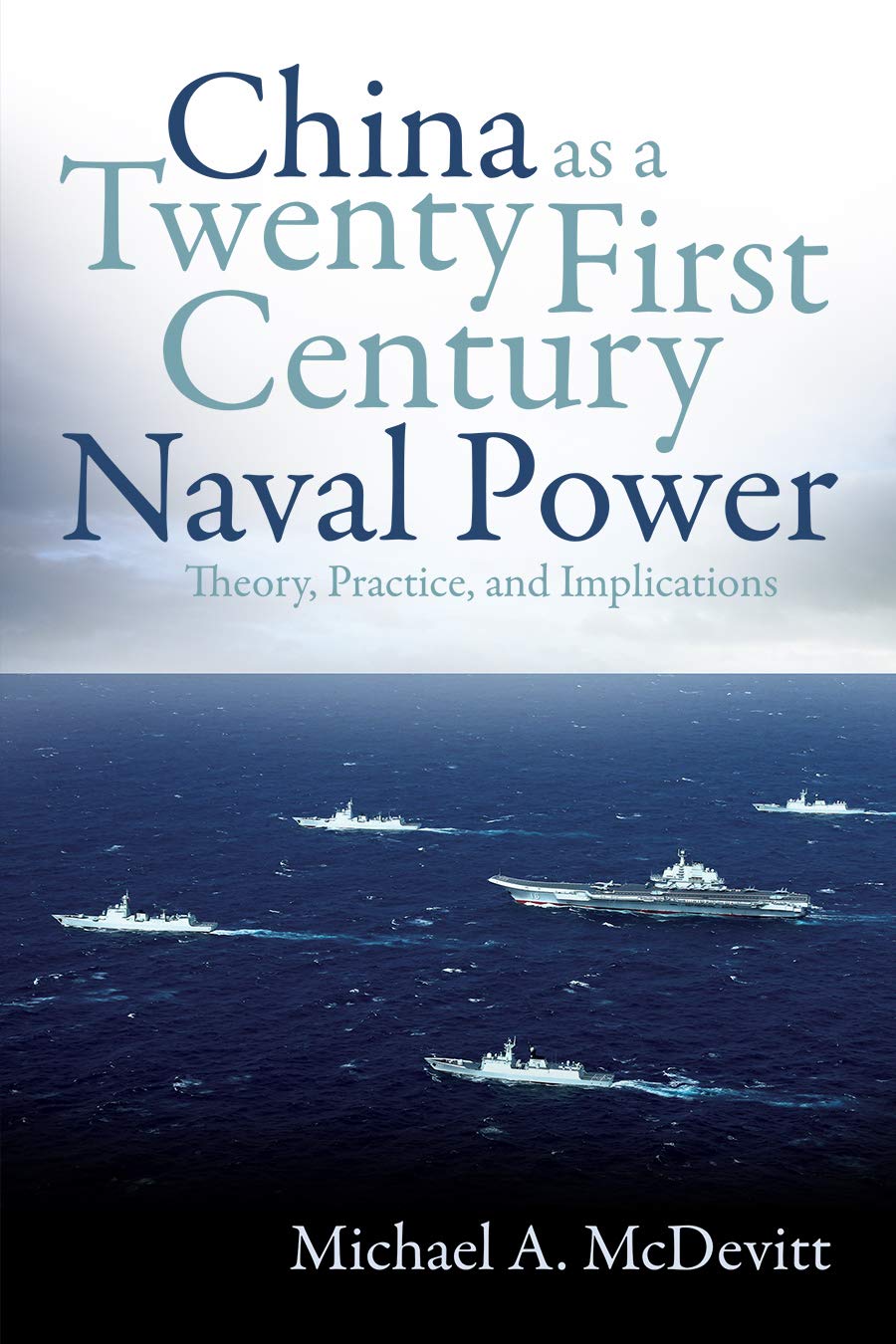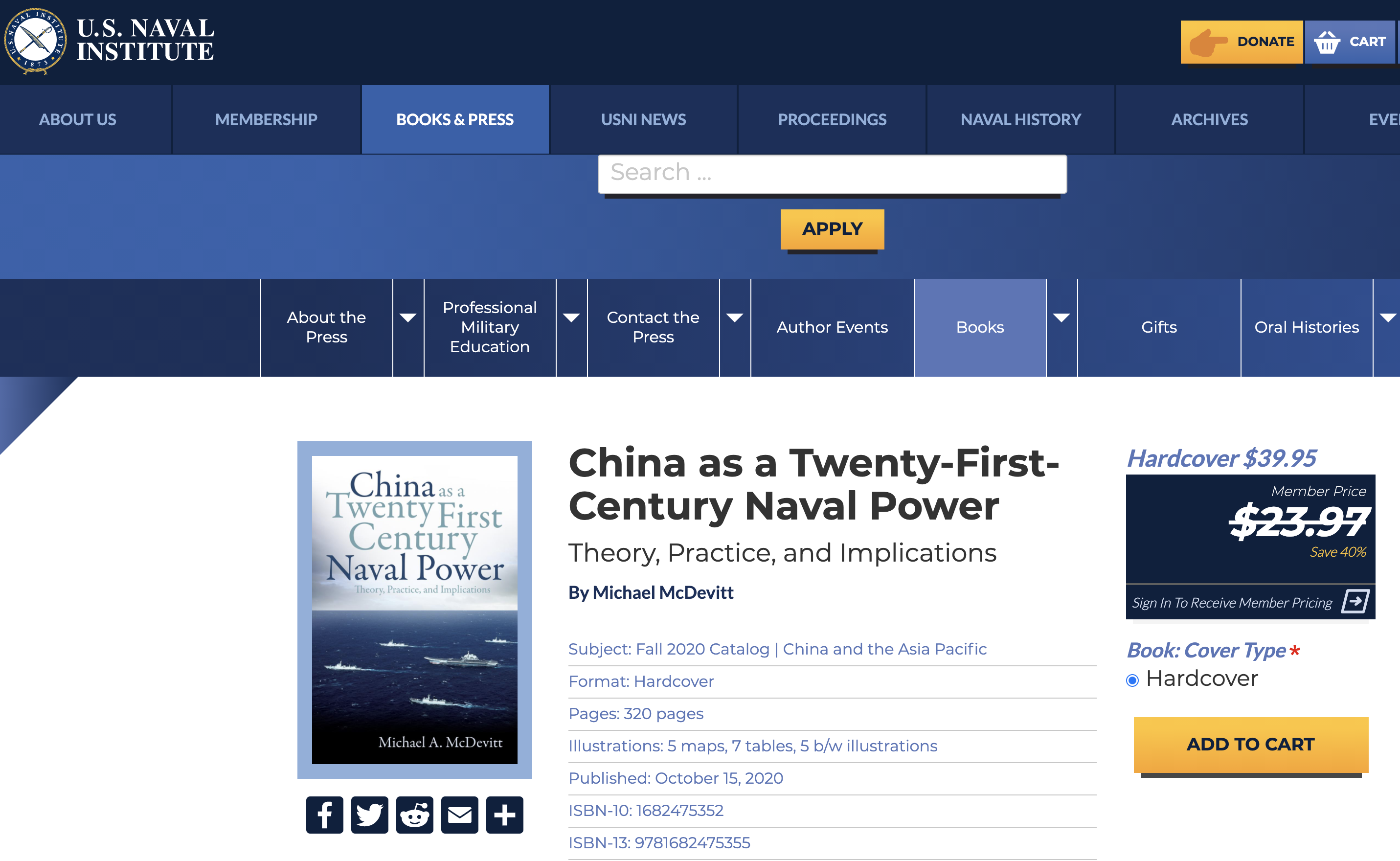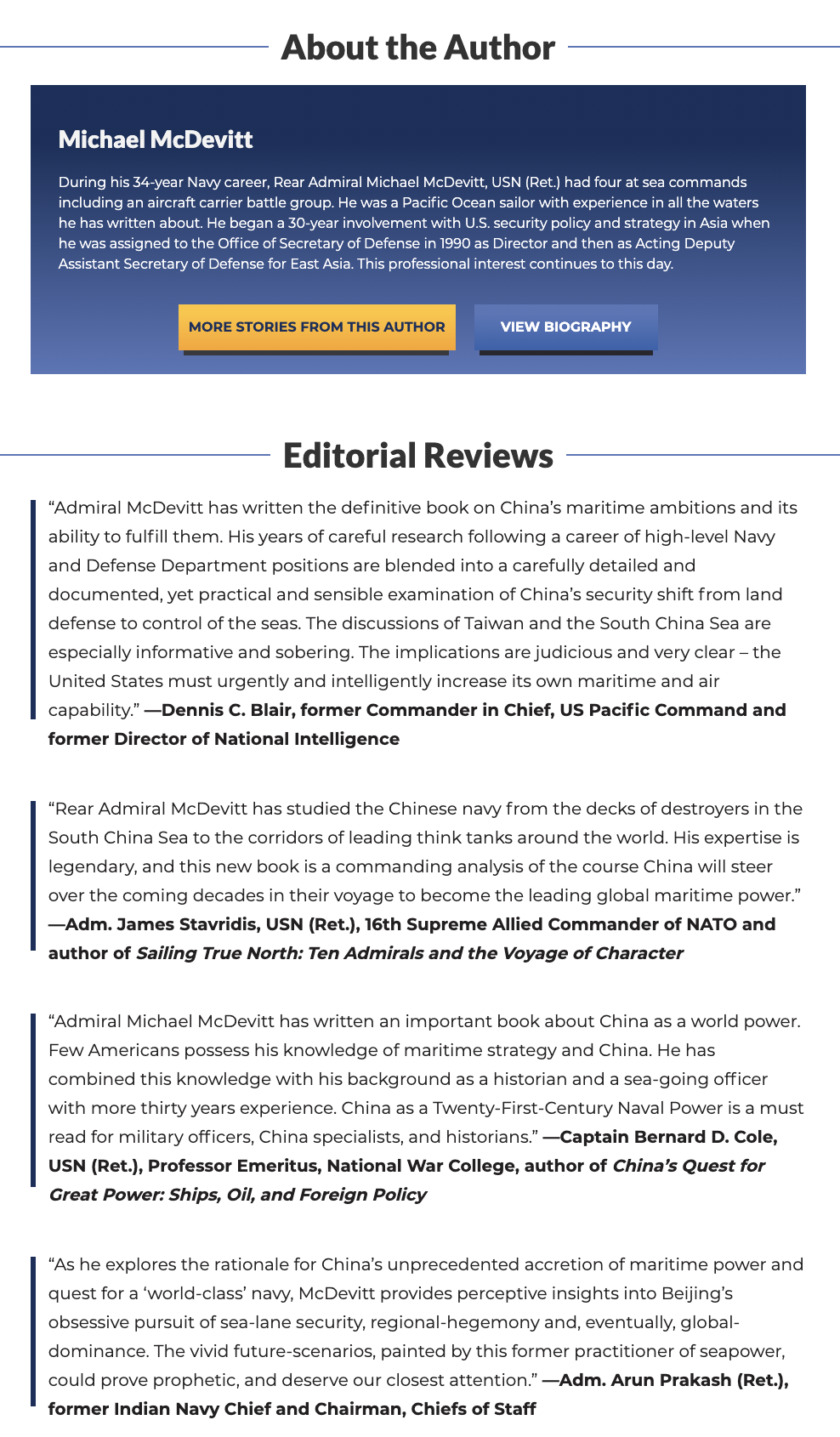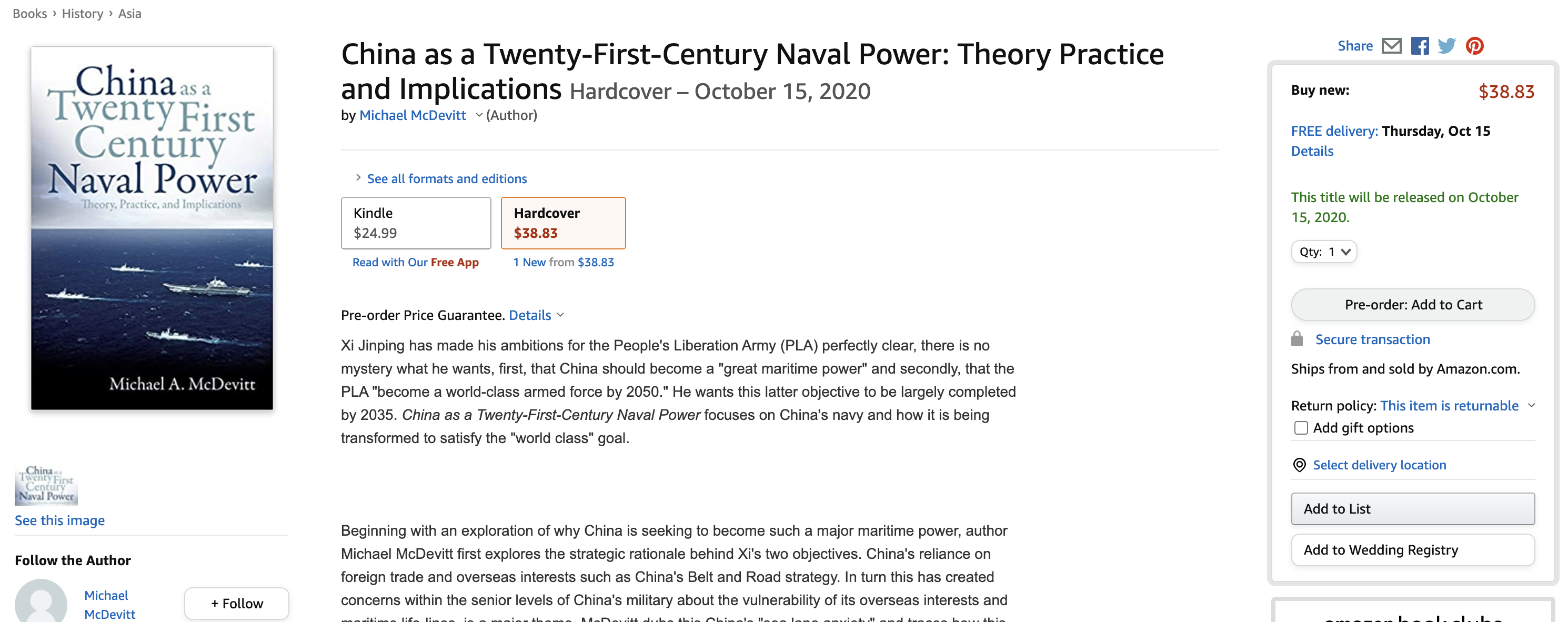Coming Next Month! “China’s Maritime Militia: An Important Force Multiplier” in Admiral McDevitt’s book on China as a 21st-Century Naval Power
Honored to contribute to Admiral McDevitt’s landmark book. This must-read volume rightly recognizes China as already having unmatched across-the-board maritime capabilities in 2020, and offers PLA Navy projections to 2035!
Andrew S. Erickson and Conor M. Kennedy, “Appendix II—China’s Maritime Militia: An Important Force Multiplier,” in Michael McDevitt, China as a Twenty-First-Century Naval Power: Theory, Practice, and Implications (Annapolis, MD: Naval Institute Press, forthcoming 15 October 2020), 207-29.
APPENDIX II
China’s Maritime Militia
An Important Force Multiplier
Andrew S. Erickson and Conor M. Kennedy
People’s Armed Forces Maritime Militia (PAFMM) is a state-organized, -developed, and -controlled force operating under a direct military chain of command to conduct Chinese state–sponsored activities.1 The PAFMM is locally organized and resourced but answers to the very top of China’s military bureaucracy: the commander in chief, Xi Jinping. While the PAFMM has been part of China’s militia system for decades, it is receiving greater emphasis today, because of its value in furthering China’s near-seas “rights and interests.”
Traditionally, the PAFMM has been a military force raised from civilian marine industry workers (e.g., fishermen). Personnel keep their “day jobs” but are organized and trained in exchange for benefits and can be called up as needed. Recently, the People’s Liberation Army (PLA— in this context, the military generally) has been adding a more professionalized, militarized vanguard to the PAFMM, recruiting former servicemen (by offering them high salaries) and launching formidable purpose-built vessels. This vanguard has no apparent interest in fishing.
This chapter focuses on the current organization and employment of Chinese maritime-militia organizations. It first puts this force into historical context by surveying the PAFMM’s background and its changing role in China’s armed forces. Next, it examines the PAFMM’s current contributions toward China’s goal of becoming a great maritime power, in both old and new mission areas. The remaining sections will address specific maritime-militia modes of command and control, intelligence gathering, organization and training and will suggest possible scenarios and implications.
Decades-Long History
China’s militia system originated before the Chinese Communist Party (CCP) came to power, but the system of recruiting numerous state- supported maritime militias from coastal populations was not fully implemented until the communists began to exercise greater control of the coastline in the 1950s. This segment of China’s population had been relatively isolated from the turmoil of the Civil War; these regions had been under either Japanese or Republic of China (ROC) control in the decades before CCP rule was established. The CCP targeted the fishing communities by creating fishing collectives and work units, enacting strict organizational and social controls, and conducting political education. Factors motivating and shaping this transformation included:
- The PLA’s early use of civilian vessels after Chiang Kai-shek’s Nationalist Party decamped to Taiwan.
- The fact that fishermen constituted the bulk of China’s experienced mariners.
- The requirement during the 1950s and 1960s to defend against Nationalist incursions along the coast.
- Increasingly frequent confrontations with other states’ fishing and naval vessels as China’s fishermen gradually began to fish farther offshore.
- The transformation of many shore-based coastal-defense militias to the at-sea maritime militia.
The PAFMM has played significant roles in manifold military campaigns and coercive incidents over the years:
- In the 1950s, support of the PLA’s island seizure campaigns off the mainland coast
- In the 1960s, securing of China’s coast against Nationalist infiltrations
- In 1974, seizure of the western portion of the Paracel Islands in the South China Sea from South Vietnam
- In 1976, harassment of “foreign” naval ships east of the Zhoushan Archipelago (south of Shanghai)
- In 1978, presence mission in the territorial sea of the Senkaku Islands
- In 1995, Mischief Reef encounter with the Philippines stemming from the occupation and development of that reef
- In 2009, harassment of USNS Impeccable
- In 2012, Scarborough Shoal stand-off with the Philippines
- In 2014, blockade of Philippine-occupied Second Thomas Shoal
- In 2014, repulse of Vietnamese vessels from disputed waters surrounding the China National Offshore Oil Corporation’s (CNOOC’s) oil rig HYSY 981
- In 2014, harassment of USNS Howard O. Lorenzen
- In 2016, large surge of fishing craft near the Senkaku Islands
- In 2017, envelopment of Philippine-claimed Sandy Cay in the northern Spratly Islands.2 … … …
About the Author
During his 34-year Navy career, Rear Admiral Michael McDevitt, USN (Ret.) had four at sea commands including an aircraft carrier battle group. He was a Pacific Ocean sailor with experience in all the waters he has written about. He began a 30-year involvement with U.S. security policy and strategy in Asia when he was assigned to the Office of Secretary of Defense in 1990 as Director and then as Acting Deputy Assistant Secretary of Defense for East Asia. This professional interest continues to this day.
Summary
Xi Jinping has made his ambitions for the People’s Liberation Army (PLA) perfectly clear, there is no mystery what he wants, first, that China should become a “great maritime power” and secondly, that the PLA “become a world-class armed force by 2050.” He wants this latter objective to be largely completed by 2035. China as a Twenty-First-Century Naval Power focuses on China’s navy and how it is being transformed to satisfy the “world class” goal.
Beginning with an exploration of why China is seeking to become such a major maritime power, author Michael McDevitt first explores the strategic rationale behind Xi’s two objectives: China’s reliance on foreign trade and overseas interests such as China’s Belt and Road strategy. In turn this has created concerns within the senior levels of China’s military about the vulnerability of its overseas interests and maritime life-lines: a major theme. McDevitt dubs this China’s “sea lane anxiety” and traces how this has required the PLA Navy to evolve from a “near seas”-focused navy to one that has global reach; a “blue water navy.” He details how quickly this transformation has taken place, thanks to a patient step-by-step approach and abundant funding. The more than 10 years of anti-piracy patrols in the far reaches of the Indian Ocean has acted as a learning curve accelerator to “blue water” status.
McDevitt then explores the PLA Navy’s role in the South China Sea and the Indian Ocean. He provides a detailed assessment of what the PLAN will be expected to do if Beijing chooses to attack Taiwan, potentially triggering combat with America’s “first responders” in East Asia, especially the U.S. Seventh Fleet and U.S. Fifth Air Force.
He conducts a close exploration of how the PLA Navy fits into China’s campaign plan aimed at keeping reinforcing U.S. forces at arm’s length (what the Pentagon calls anti-access and area denial [A2/AD]) if war has broken out over Taiwan, or because of attacks on U.S. allies and friends that live in the shadow of China. McDevitt does not know how Xi defines “world class” but the evidence from the past 15 years of building a blue water force has already made the PLA Navy the second largest globally capable navy in the world. This book concludes with a forecast of what Xi’s vision of a “world-class navy” might look like in the next fifteen years when the 2035 deadline is reached.
Reviews
“Rear Admiral Mike McDevitt delivers the definitive study on China’s ambitious quest for greatness at sea. Armed with decades of operational experience, he renders persuasive judgments about China’s nautical ascent. For those looking for an authoritative yet accessible appraisal of the Chinese navy, this is it.”
— Toshi Yoshihara, senior fellow, Center for Strategic and Budgetary Assessments, co-author of Red Star over the Pacific: China’s Challenge to U.S. Maritime Strategy, 2nd ed.
“In order to counter China’s willful and persistent challenges against the stabilizing PAX-AMERICANA global framework, an accurate and comprehensive understanding of China’s security and naval strategies is required. In this context, RADM Mike McDevitt’s superb book is a ‘must-read’ for naval/security specialists, as well as national leaders and thinkers.”
— Yoji Koda, Former Commander in Chief, JMSDF Fleet
“Admiral Michael McDevitt has written an important book about China as a world power. Few Americans possess his knowledge of maritime strategy and China. He has combined this knowledge with his background as a historian and a sea-going officer with more thirty years’ experience. China as a Twenty-First-Century Naval Power is a must read for military officers, China specialists, and historians.”
— Captain Bernard D. Cole, USN (Ret.), Professor Emeritus, National War College, author of China’s Quest for Great Power: Ships, Oil, and Foreign Policy
“Admiral McDevitt has written the definitive book on China’s maritime ambitions and its ability to fulfill them. His years of careful research following a career of high-level Navy and Defense Department positions are blended into a carefully detailed and documented, yet practical and sensible examination of China’s security shift from land defense to control of the seas. The discussions of Taiwan and the South China Sea are especially informative and sobering. The implications are judicious and very clear – the United States must urgently and intelligently increase its own maritime and air capability.”
— Dennis C. Blair, former Commander in Chief, US Pacific Command and former Director of National Intelligence
“Rear Admiral McDevitt has studied the Chinese navy from the decks of destroyers in the South China Sea to the corridors of leading think tanks around the world. His expertise is legendary, and this new book is a commanding analysis of the course China will steer over the coming decades in their voyage to become the leading global maritime power.”
— Adm. James Stavridis, USN (Ret.), 16th Supreme Allied Commander of NATO and author of Sailing True North: Ten Admirals and the Voyage of Character
“As he explores the rationale for China’s unprecedented accretion of maritime power and quest for a ‘world-class’ navy, McDevitt provides perceptive insights into Beijing’s obsessive pursuit of sea-lane security, regional-hegemony and, eventually, global-dominance. The vivid future-scenarios, painted by this former practitioner of seapower, could prove prophetic, and deserve our closest attention.”
— Adm. Arun Prakash (Ret.), former Indian Navy Chief and Chairman, Chiefs of Staff
Product details
Publisher : Naval Institute Press (October 15, 2020)
Subject: Fall 2020 Catalog | China and the Asia Pacific
Item Weight : 2.5 pounds/40 oz
Product Dimensions: 9 × 6 × 1 in
Hardcover : 320 pages
Illustrations: 5 maps, 7 tables, 5 b/w illustrations
ISBN-10 : 1682475352
ISBN-13 : 978-1682475355









































